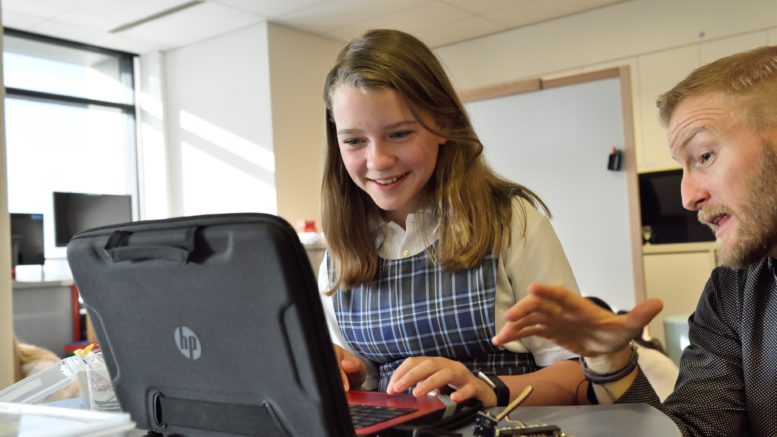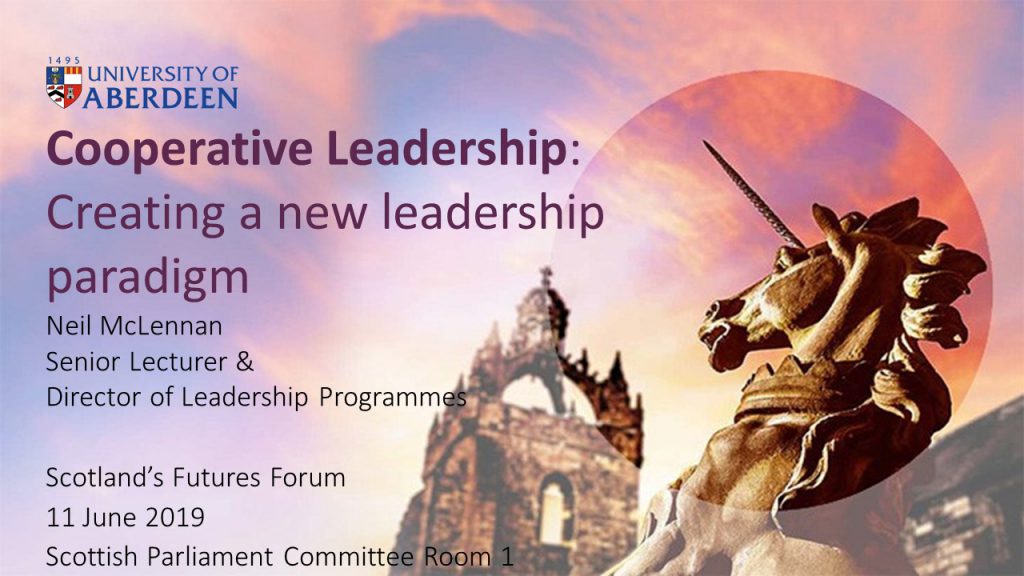Tuesday 11 June 2019, at the Scottish Parliament
This seminar, chaired by Sir Andrew Cubie, was the second in a series of debates focusing on leadership in education, particularly leadership of change. It featured a presentation from Neil McLennan, Director of Leadership programmes at the University of Aberdeen, a small-group workshop session and reflections from an invited panel of educators.
Presentation
Co-operative Leadership: Creating a New Leadership Paradigm in Scottish Education. Neil McLennan, Director of Leadership Programmes, University of Aberdeen
What will leadership in schools look like in 2030?
Neil opened his presentation by stating upfront his aspiration to see a co-operative leadership model (based on the principles of co-operative learning) developed in Scotland to support better learning outcomes.
His research and scholarship draws on a personal interest in the messages of the Great War poets on conflict and co-operation, and a professional interest in leadership models.
The term ‘leadership’ is increasingly used in education, particularly in relation to thinking on educational improvement. While reflections on leadership are not new, there has been a significant growth in writing in this area. Thinking has swung between ‘great man’ charisma-based leadership, and situational constructs. Neil stated that his interest is in the interaction between the leader and the group, and the interactions among the group, rather than just the sole focus being on the leader per se.
He suggested that the sustainability agenda and intergenerational projects could see a move away from a model of constant statistically focused improvement by command and control, towards one of agreed philosophy and achieving sustainable stability. Before exploring a new, more nuanced paradigm, he provided an overview of the current narrative around leadership in Scotland.
In Scotland, rhetoric on leadership, and distributed leadership specifically, especially in policy documents, began to be ramped up in 2007. Neil referred to his 2009 TESS article suggesting a national educational leadership programme beyond just that for Head Teachers; the 2010 Donaldson report recommending a virtual college for educational leadership; and the 2014 establishment of the Scottish College for Educational Leadership.
In an attempt to move towards a more democratic model, ‘distributed leadership’ became the prevailing narrative in Scottish education. However, distributed leadership is a contested concept. Neil shared that the concept had been the subject of a number of critiques, in particular from Deidre Torrance (University of Edinburgh) who noted that the concept assumes the following:
- every member of staff is able to lead;
- every member of staff wishes to lead;
- leadership is legitimised by Head Teacher endorsement;
- leadership occurs naturally; and
- the distributed perspective is unproblematic.
In addition, it has been critiqued by academics as being, theoretically weak, politically driven and as having economic outcomes at its heart.
And yet, results from a social media campaign undertaken by Scottish College for Educational Leadership suggest that many educationalists associate distributed leadership with what leadership is.
Responses associated with transformational models also feature in responses, while a small number cited statements aligned with traditional command and control models as what they associated with leadership.
Within the same set of responses, another small group spoke about care, compassion, co-operation and values, which could be wrapped up into a new inclusive, sustainable and co-operative leadership model.
Research, mainly from Canada, has demonstrated how moving to co-operative learning has improved students’ learning and social outcomes. On the basis of such research, Neil proposed that Scotland moves away from distributive leadership to a co-operative leadership model.
Such a model would embody the values cited above by building on the five principles of co-operative learning:
- positive interdependence (everyone working together with roles and responsibilities which collectively support outcomes);
- individual and group accountability (management functions);
- group processing/group cohesion (must be established from the outset);
- social skills (culture, climate and the behaviours and values); and
- face-to-face interaction (emotional intelligence).
Neil argued that these principles could provide a leadership approach that would advance collegiate involvement through democratic working and decision making, and promote creative collaboration within a consciously promoted positive culture.
Within that, all would still have clear roles, responsibilities and accountabilities.
However, teams would be supported and encouraged to consider formation and cohesion, together with the social skills and interactions which make these roles, responsibilities and accountabilities work towards the achievement of outcomes.
He ended his presentation by asking others to reflect on whether a co-operative leadership model could work in Scotland’s schools and help improve outcomes for Scotland’s young people.
Discussion and reflections
Following the presentation, participants were asked to work in groups of four, essentially to experience a co-operative model of working and discuss leadership in Scottish education past, present and future. An invited panel was also asked to provide their reflections and thoughts. The Educators Panel consisted of:
- Isabelle Boyd: Former Director of Education and Depute CEO North Lanarkshire
- Robin MacPherson: Assistant Rector, Dollar Academy
- Jane Minelly: Head Teacher at BothwellPark High School Motherwell
- Iain White: Former Principal of Newlands College
- Professor Jim Scott: Professor of Educational Leadership, University of Dundee
Each panel member brought different perspectives to the discussion and these, along with the key points from the group discussions are set out below.
Educational leadership in the past
‘Command and control’ was the overall theme that came through when reflecting on educational leadership in the past.
The leadership features suggested at the different levels were:
- Student Leadership – limited; good students rewarded; prefect systems and pupil councils but with minimal training.
- Teacher Leadership – dependent on context and circumstances; more focus on teaching and leadership extra-curricular; more autonomy; the leadership style– authoritative.
- Middle Leadership – pulled between headship and teachers; subject driven; structured, career-ladder model.
- School Leadership – command and control; highly structured; management driven; time served model.
- System Leadership – command and control; leadership at Director of Education level; local authority and parish based.
It was noted that of the 51 significant Scottish educational initiatives since 1946, almost one third have been evaluated by commentators including (Priestley & Miller, 2012) as successful or highly successful, one third as achieving some of their objectives, and slightly more than a third as failures (including those which had not got off the ground at all).
It was suggested Scottish educational leaders have had a habit of abandoning failed or limping initiatives and, as a result leadership, has not been particularly effective, particularly in the upper and middle layers of the education system.
Present Educational Leadership
One contributor suggested the school report for our current leadership policies and models might say ‘could do better’.
Despite, or perhaps due to, the early flourishing of educational leadership in Scotland, Scottish education is still deemed to be very hierarchical within a culture of control, uniformity, and compliance.
In contrast, in Europe and beyond, government, governance and leadership are generally different. Sixty miles south of Edinburgh, a very different educational leadership landscape begins, where the hierarchical model of governance is no longer the predominant model. However, it was noted the ‘free market’ approach also presents a different set of both opportunities and challenges.
The Scottish College of Educational Leadership (SCEL) has had a successful start, spearheading professional development for the education community. It was asked what is next for this organisation and what role should it have in shaping a new leadership paradigm.
Participants were asked how leadership in Scottish education presently looked, felt and sounded like. There was acknowledgment by participants that there is currently a significant focus on leadership. For some, leadership was an area that was evolving, with people passionate and committed to exploring it.
However, others commented that at present Scottish educational leadership looks disjointed and hierarchical and that it is generally unclear and confused.
When discussing the present levels of leadership, the features suggested included:
- Student Leadership – emerging student voice; greater involvement; more co-creation of the curriculum, especially in the early years and at primary level; school-dependent; external opportunities.
- Teacher Leadership – on a journey supported by leadership programmes by organisations such as the Scottish College of Educational Leadership; variable; school-dependent; limited autonomy; initiative-led e.g. eco and digital ‘champions’.
- Middle Leadership – collaborative; fewer so stretched; generic; supported by teacher ‘champions’.
- School Leadership – school management; variable; top-down scrutiny; compliance; democratic; distributed.
- System Leadership – government policy led; local authority as deliverers; limited succession planning; overly focused on planning.
It was suggested that leadership initiatives have lacked the underpinnings of theory and research. Complexity Theory, Metagovernance, Networked Leadership and the Austrian model of joint learning process were all suggested as having the potential to contribute to improved educational leadership. The limited success of initiatives to date has meant that the pace of change in the education system is seen as slow and inadequate for the 21st Century.
There was a view that the hierarchical nature of the current system has allowed a ‘consensus of elites’ to lead and govern Scottish education by instructing lower governance layers to implement tasks, with or without genuine discussion. This largely disenfranchises pupils, parents and teachers while placing the onus on Head Teachers for social outcomes that may lie beyond their control.
It was argued that it was impossible for Head Teachers to help create a ‘smarter, stronger, fairer and healthier Scotland’ without more cohesive social policy across the public sector.
Could some changes in education be less radical than the narrative would lead us to believe? An example given was the recently redrafted Head Teachers Charter; some have found it diffcult to see where there is greater empowerment than Head Teachers have already.
In addition, it was felt that much of the current dialogue on leadership concentrates on the middle and lower layers of the system (from Head Teacher to class teacher) This has led to the prevailing view across government and national agencies that those who lead schools are the principal agents of improvement or failure and the associated rise of performativity and accountability as means of ‘governance by output’.
As a result, Head Teachers are generally seen as a panacea for most leadership challenges. and where the contested concept of ‘distributed leadership’ (Hargreaves and Fink, 2008; Leithwood, Mascali and Strauss, 2009) fulfils the remaining aspects.
One participant was initially encouraged when reading headline information about education in 21st Century Scotland, for example in How Good is Our School (HGIOS 4) where we see guidance for: Looking Inwards, Looking Outwards, Looking Forward.
On taking a closer look, they found that the looking inwards/outwards and forward is still very school-centric. For example, in exploring Leadership of Change, the illustration of good practice is to shape a vision through understanding ‘the social, economic and cultural context in which children, young people and their families live, alongside our awareness of current policy and practice’. However, it was noted that there is currently no guidance or structures to support this process.
As a result, despite references to the school and its community in policy documents, the community may be perceived as a ‘sound bite with no teeth’. There were also concerns that when consultation is undertaken, any changes tend to be based on the views of a small group of people.
Educational leadership in the future
Drawing on different theorists, by 2030, should there be a ‘reassembly’ of governance (Clarke & Newman, 2009) in education, taking educational leadership and governance ‘beyond public bureaucracy’ (Hood,1990)? The thoughts and ideas highlighted in the session suggest this should be the direction of travel.
Leadership is deemed crucial to truly delivering ‘equity and excellence’ in Scottish education by 2030. From the group discussions, the following features of our leaders in the future were highlighted:
- Student Leadership – co-producers of learning experience and curriculum; empowered; collaboration; elected representatives on governing body; clear leadership roles and responsibilities; no longer tokenistic.
- Teacher Leadership – voice of class teacher; interactive; connected with other education providers; networked; collaboration; personal responsibility; creating space for those who want to lead; talent spotting.
- Middle Leadership – faculty or subject based
- School Leadership – motivated; enabled; brave; teachers’ parents’ and community’s voice.
- System Leadership – empowered; effective, long-term collaborations; child-centred; appropriately scaled; immersive.
In looking at future leadership there was a strong view that we need to revisit our aims for society as a whole and then develop leadership models in our education system that facilitate that vision.
A shared vision would also support the delivery of inclusive education across the country, rather than making it dependent on the priorities of individual local authorities. It was not deemed sufficient to empower schools without a clear message about overall aims.
Leadership is about relationships, not a person or a process. In recognition of this, there was a strong view that a shared set of values should underpin leadership in the future and determine the culture of the education system. It was suggested that the system should be characterised by the expression: ‘Open mind, Open heart, Open will’.
Leadership should embody care, compassion and co-operation, and prioritise emotional intelligence ahead of a high IQ or good grades. Within this model of leadership, the wellbeing of teachers and support staff would be prioritised.
In addition to creating a shared set of values, the following principles were suggested for educational leadership in the future:
- A much greater degree of heterarchy and collaborative leadership (Rubin, 2009) or co-operative leadership in Scottish educational leadership. The hierarchical model of governance replaced by ‘governing by network’ (Bevir & Rhodes, 2003, p.41; Eggers, 2008). with ‘top-down’ being largely replaced by ‘bottom-up’ and ‘across’;
- The consistent use of research and theoretical frameworks to guide, develop and inform the leadership and improvement of Scottish education;
- Greater realism and honesty on the part of national and local government about what they themselves must do to support school, classroom and home leadership, and about the extent to which they also should be subject to ‘governance by output’.
- A move from hierarchically imposed policy (and blame) to shared learning, improvement and responsibility.
These structures will empower people at all levels of the system to innovate and offer opportunities, particularly for those at middle leadership level, to enable change and encourage co-operation. They will also offer greater flexibility and more responsiveness with learners, families and teachers having not just a ‘voice’, but a meaningful role in the leadership of learning. In addition, they will encourage leadership that is prepared to ask “Why?” and say “No.”
A new leadership paradigm, rooted in the wider community, will see the student at the top of the leadership pyramid rather than at the bottom.
The model of the future might no longer have a set, promoted-post structure, but allow positions of responsibility to change regularly and create space for those who want to lead. This will ensure that Head Teachers are better prepared for their role. It was also proposed that by 2030 there should be a fixed term contract for Head Teachers in one setting (initially 6 years with a 4 year ‘option’ at the end) beyond which the individual must move on to keep vibrant and fresh.
SCEL will evolve into a newly created Leadership Academy bringing together leaders from across the public sector and encourage networks that can promote real system change to engender a better and fairer society.
What Next – Food for Thought
In addition to reflecting on the leaders of the past, present and future, participants also raised broader questions and concerns around the general area of leadership in education.
In exploring different models of leadership, caution was raised about not losing sight of the products of education. It was also noted that, while Getting it Right for Every Child should inform our leadership models, policy and practice, this is not currently the case.
In addition, concerns were raised about whether there will be enough male leadership role models in Scottish education for young people in 2030, and around the danger of reverting to a top-down model of leadership if results were not forthcoming from a collaborative model.
Questions were asked about how we create trust within the education system, and how we develop a shared understanding of the ideal leadership approach. In addition, there was discussion around why change is not happening when there is so much agreement around the need for change.
The co-operative leadership model also provoked further debate. It was suggested that for co-operative leadership to work we would need to see a flattening of structures, and schools that are much more dynamic and flexible. There was also a view that we need to look at the nurture principles to develop a leadership model, especially when we are striving to embed these principles for the benefit of children.
Further detail was requested on how the model compares to Michael Fullan’s work around collaborative professionalism as well as on what co-operative leadership will impact, and how we will know when the desired change has been achieved.



